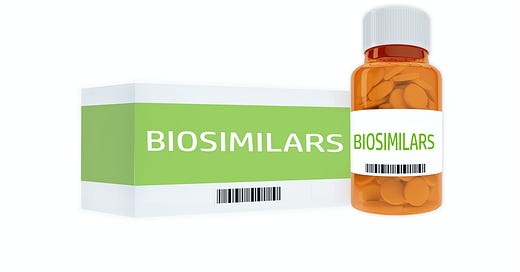Help for diabetics is on the way
Non-profit manufacturer plans to deliver low-cost insulin within two years
When President Biden promised a $35-a-month cap on out-of-pocket costs for insulin, I immediately wondered how it would work. Did the administration plan to subsidize consumers directly? Would it simply shovel more cash to the major drug companies that have been overcharging diabetics for decades? Or would it require insurers, Medicare and Medicaid to pick up most of the high cost of insulin, which will lead to higher premiums and taxes on everyone?
With the drug industry’s vast army of lobbyists controlling Capitol Hill, there’s little chance Medicare will be given the authority to negotiate lower prices, another long-standing Democratic Party demand that the president raised during his State-of-the-Union address. And forget about using price controls to limit government exposure in providing this new benefit. That’s anathema to most members of his own party.
Right on cue, the non-profit consortium CivicaRx announced plans this morning to begin manufacturing low-cost generic insulin at a new factory under construction in Petersburg, Va., which is slated to open in early 2024. The non-profit drug manufacturer and distributor, whose backers include 55 health systems representing a third of all hospital beds in the U.S., estimates it will be able to price its biosimilar insulin at $30 a vial or a tenth of what Big Pharma charges. The average diabetic uses about two vials of insulin per month.
I’ve been writing about CivicaRx (most recently here) since Salt Lake City-based Intermountain Health and a few allies launched the non-profit in 2018. Its initial goal was to produce generic drugs in short supply at hospitals.
Market failure
The Food and Drug Administration currently lists more than 100 drugs in short supply, virtually all of them generics. It’s a classic case of market failure in most of those situations.
When a drug comes off patent, generic firms race to supply the new market. Their fierce competition drives the price to barely above the cost of manufacturing, which leads less efficient producers to discontinue production. To combat the resulting shortages, CivicaRx is now providing about 60 products to its hospital system members, all of them produced by contract manufacturers given long-term supply contracts.
Producing generic insulin on a non-profit, cost-plus basis will be its first foray into direct manufacturing. Company officials estimate it will spend $125 million over the next two years to bring generic insulin, a complex biologic, to market.
Why so much? The company must overcome the numerous regulatory roadblocks erected by Congress at the behest of the biotechnology industry in the 2009 Biologics Price Competition and Innovation Act, which guaranteed biosimilars would come to market at prices close to the brand name drugs they hoped to supplant. Chief among them is the requirement that generic biologics manufacturers conduct switching trials in actual patients before receiving the nod from the FDA that allows a biosimilar to be exchanged for the brand name product at the pharmacy counter.
But even factoring in those added costs, CivicaRx’s insulin price will be far below the first insulin biosimilar to hit the market. CivicaRx plans to produce three insulins: glargine, lispro and aspart, which will be interchangeable with Lantus (Sanofi), Humalog (Eli Lilly) and Novolog (Novo Nordisk) respectively.
Though these drugs have been off patent for years, the only biosimilar substitute approved so far is Viatris’ Semglee for Lantus. When it came to market, its manufacturer set the price at $270 a vial, just $20 below its brand name equivalent.
Mission driven
That’s why the presence of a mission-driven, non-profit manufacturer in the generic drug space is vitally important. “Civica plans to sell its insulins at one low, transparent price for all, basing the price on the cost of manufacturing,” the company said in its press release. That price, which will reflect the added cost of the clinical trials, will be “no more than $30 a vial and no more than $55 for a box of five pen cartridges, (is) a significant discount to the prices charged today.”
The mainstream institutions behind CivicaRx — health care providers, insurers, business groups, patient advocacy groups and consumers — are traveling a well-worn path in American history. Publicly-owned utilities, labor-owned banks, farm co-ops and non-profit credit unions are among the many institutions that civic-minded groups and individuals have set up over the years to deliver socially important goods at reasonable prices for their residents and members.
This approach ought to be on the table again as policymakers grapple with the latest bout of inflation. Should Congress fail to give Medicare the right to negotiate drug prices, insurers, hospitals, doctors and patients could form a non-profit, co-operative pharmacy benefit management company to negotiate all drug prices, which I proposed in my article on why insulin should be free in Democracy: A Journal of Ideas.
There’s also a need, as the climate crisis escalates, for a non-profit, mission-driven consortium to tackle the soaring price of oil. It could use its buying power to influence nor just the price of energy, but its sources.
Unless there is an electoral miracle this fall, the prospects for legislative action on the nation’s most pressing problems will be severely diminished. Voter suppression, money-as-speech, the undemocratic Senate and gerrymandering will have triumphed over the voices of the majority of citizens.
CivicaRx provides a useful template. The time to begin building non-governmental institutions that can tackle our multiple crises is now.




